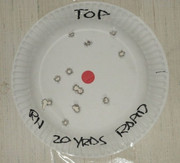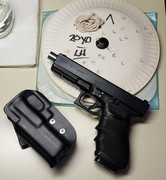I want to make sure I'm a relatively proficient shooter and want to be sure that not only my 43x is reliable but I am reliable as a shooter. I try to train diligently including getting occasional individual instruction and have recently been going to tactical classes. I am aware that I fight jerking the trigger and have diligently worked on that- and in tactical group I have totally disregarded the clock, taking exponentially more time than others in the group to get the mechanics right. But my POA and POI don't seem to correlate no matter how diligent I am.
Below find a photo of a 10 shot laser group that is representative of what I consistently produce in a 34' hallway, the approximate distance from most of the targets in last night's drills. With a lasert bullet in my 43x I can keep all my shots consistency well within an 8" target at 64 feet (21 yards). But with live rounds, aware of being super smooth with follow thru on my trigger pull I still have difficulty getting POI on 8" steel targets at 30'. There were multiple times when I'd expend 4 or 5 rounds to hit a single steel target no matter how diligent I was, with focus only on proper mechanics and execution.
My rear sight was mechanically centered by an armorer though never technically "zeroed".
I know the first line of reason is "more training". I have been made aware of my tendency to jerk and to pull left, but have been working on that for over a month. I've slowed everything down and yet, the POA is consistently left and when the target is small I get a no-hit with ammo, but at 34' with laser in this same 43x I consistently get 2" groups. I'm trying not to compensate but focus on solid mechanics to no avail.
So when's it time to have the rear moved over? Could a steel/tungsten guide rod possibly help? Other than practice, which is what I try to do a good amount of, what's next?
Thanks in advance for any advice that might put me in the right direction.
Below find a photo of a 10 shot laser group that is representative of what I consistently produce in a 34' hallway, the approximate distance from most of the targets in last night's drills. With a lasert bullet in my 43x I can keep all my shots consistency well within an 8" target at 64 feet (21 yards). But with live rounds, aware of being super smooth with follow thru on my trigger pull I still have difficulty getting POI on 8" steel targets at 30'. There were multiple times when I'd expend 4 or 5 rounds to hit a single steel target no matter how diligent I was, with focus only on proper mechanics and execution.
My rear sight was mechanically centered by an armorer though never technically "zeroed".
I know the first line of reason is "more training". I have been made aware of my tendency to jerk and to pull left, but have been working on that for over a month. I've slowed everything down and yet, the POA is consistently left and when the target is small I get a no-hit with ammo, but at 34' with laser in this same 43x I consistently get 2" groups. I'm trying not to compensate but focus on solid mechanics to no avail.
So when's it time to have the rear moved over? Could a steel/tungsten guide rod possibly help? Other than practice, which is what I try to do a good amount of, what's next?
Thanks in advance for any advice that might put me in the right direction.
















